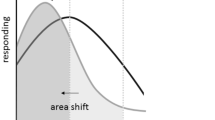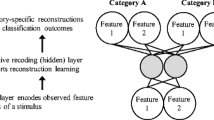Abstract
A mathematical model is developed in an attempt to relate errors in multiple stimulus-response situations to psychological inter-stimulus and inter response distances. The fundamental assumptions are (a) that the stimulus and response confusions go on independently of each other, (b) that the probability of a stimulus confusion is an exponential decay function of the psychological distance between the stimuli, and (c) that the probability of a response confusion is an exponential decay function of the psychological distance between the responses. The problem of the operational definition of psychological distance is considered in some detail.
Similar content being viewed by others
References
Attneave, F. Dimensions of similarity.Amer. J. Psychol., 1950,63, 516–556.
Blumenthal, L. M. Theory and applications of distance geometry. Oxford: Clarendon Press, 1953.
Brown, J. S., Bilodeau, E. A., and Baron, M. R. Bidirectional gradients in the strength of a generalized voluntary response to stimuli on a visual-spatial dimension.J. exp. Psychol., 1951,41, 52–61.
Busemann, H. The geometry of geodesics. New York: Academic Press, 1955.
Bush, R. R. and Mosteller, F. A model for stimulus generalization and discrimination.Psychol. Rev., 1951,58, 413–423.
Bush, R. R. and Mosteller, F. Stochastic models for learning. New York: Wiley, 1955.
Duncan, C. P. Development of response generalization gradients.J. exp. Psychol., 1955,50, 26–30.
Estes, W. K. Towards a statistical theory of learning.Psychol. Rev., 1950,57, 94–107.
Frick, F. C. An analysis of an operant discrimination.J. Psychol., 1948,26, 93–123.
Gibson, E. J. Sensory generalization with voluntary reactions.J. exp. Psychol., 1939,24, 237–253.
Gulliksen, H. and Wolfle, D. L. A theory of learning and transfer: I.Psychometrika, 1938,3, 127–149.
Guttman, N. and Kalish, H. I. Discriminability and stimulus generalization.J. exp. Psychol., 1956,51, 79–88.
Hovland, C. I. The generalization of conditioned responses: I. The sensory generalization of conditioned responses with varying frequencies of tone.J. gen. Psychol., 1937,17, 125–148.
Hovland, C. I. Human learning and retention. In S. S. Stevens (Ed.), Handbook of experimental psychology. New York: Wiley, 1951.
Hull, C. L. Principles of behavior. New York: Appleton-Century, 1943.
Kelley, J. L. General topology. New York: Van Nostrand, 1955.
Messick, S. J. Some recent theoretical developments in multidimensional scaling.Educ. psychol. Measmt, 1956,16, 82–100.
Messick, S. J. and Abelson, R. P. The additive constant problem in multidimensional scaling.Psychometrika, 1956,12, 1–15.
Margolius, G. Stimulus generalization of an instrumental response as a function of the number of reinforced trials.J. exp. Psychol., 1955,49, 105–111.
Noble, M. E. and Bahrick, H. P. Response generalization as a function of intratask response similarity.J. exp. Psychol., 1956,51, 405–412.
Pillsbury, W. B. A study in apperception.Amer. J. Psychol., 1897,8, 315–393.
Plotkin, L. Stimulus generalization in Morse code learning.Arch. Psychol., 1943,40, No. 287.
Rosenbaum, G. Stimulus generalization as a function of level of experimentally induced anxiety.J. exp. Psychol., 1953,45, 35–43.
Thurstone, L. L. Multiple-factor analysis. Chicago: Univ. Chicago Press, 1947.
Torgerson, W. S. Multidimensional scaling: I. Theory and method.Psychometrika, 1952,17, 401–420.
Woodworth, R. S. and Schlosberg, H. Experimental psychology. New York: Holt, 1955.
Young, G. and Householder, A. S. Discussion of a set of points in terms of their mutual distances.Psychometrika, 1938,3, 19–22.
Author information
Authors and Affiliations
Additional information
This paper is based upon the theoretical sections of a Ph.D. dissertation submitted to the Graduate School of Yale University and upon subsequent modification carried out on a National Academy of Sciences-National Research Council Postdoctoral Associateship at the Naval Research Laboratory. The author is particularly indebted to Drs. C. I. Hovland, R. P. Abelson, and B. S. Rosner for their generous advice and support. Helpful criticisms have also been contributed by Drs. G. A. Miller, F. A. Logan, W. D. Garvey, J. G. Holland, and H. Glaser.
Rights and permissions
About this article
Cite this article
Shepard, R.N. Stimulus and response generalization: A stochastic model relating generalization to distance in psychological space. Psychometrika 22, 325–345 (1957). https://doi.org/10.1007/BF02288967
Received:
Revised:
Issue Date:
DOI: https://doi.org/10.1007/BF02288967




